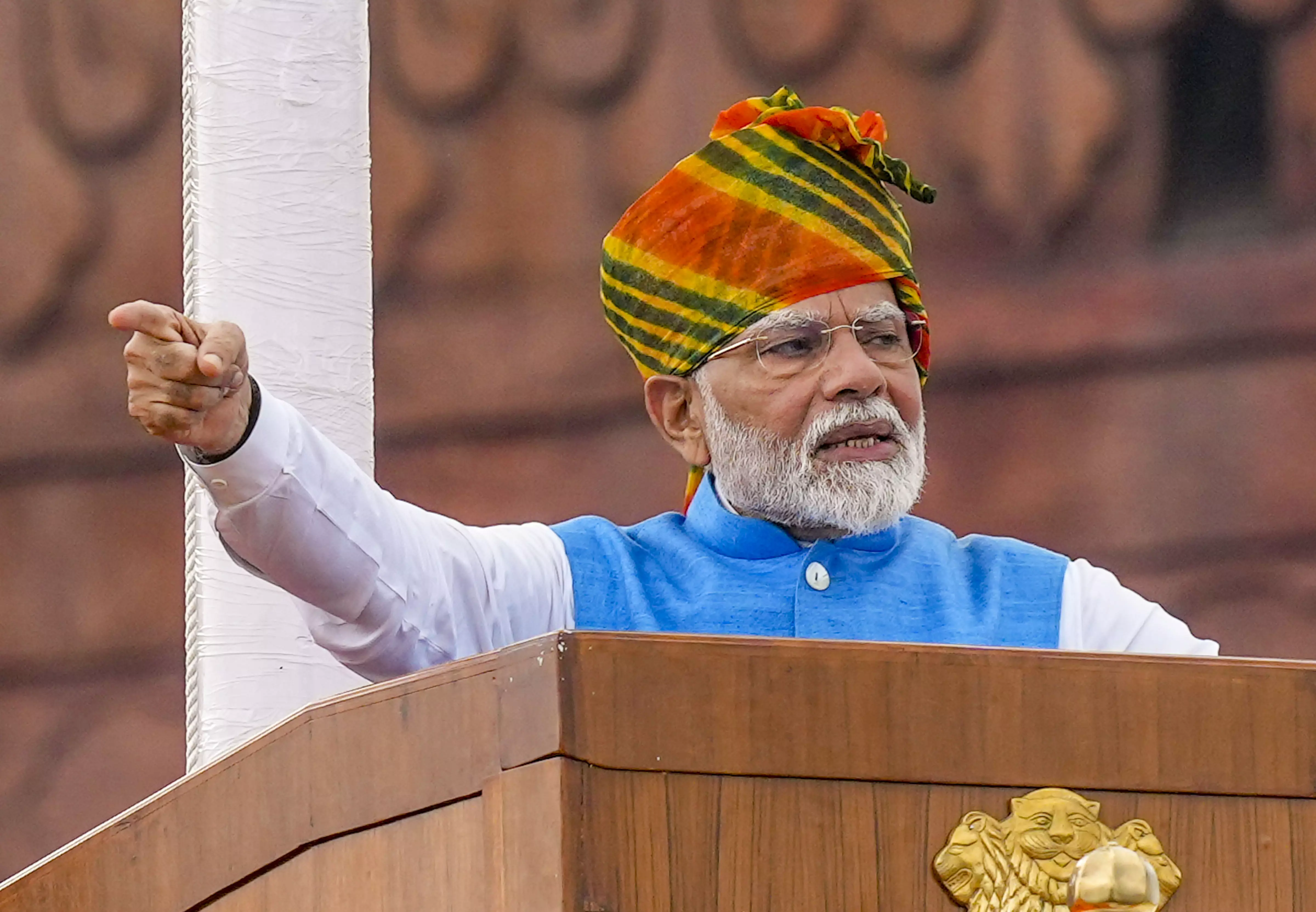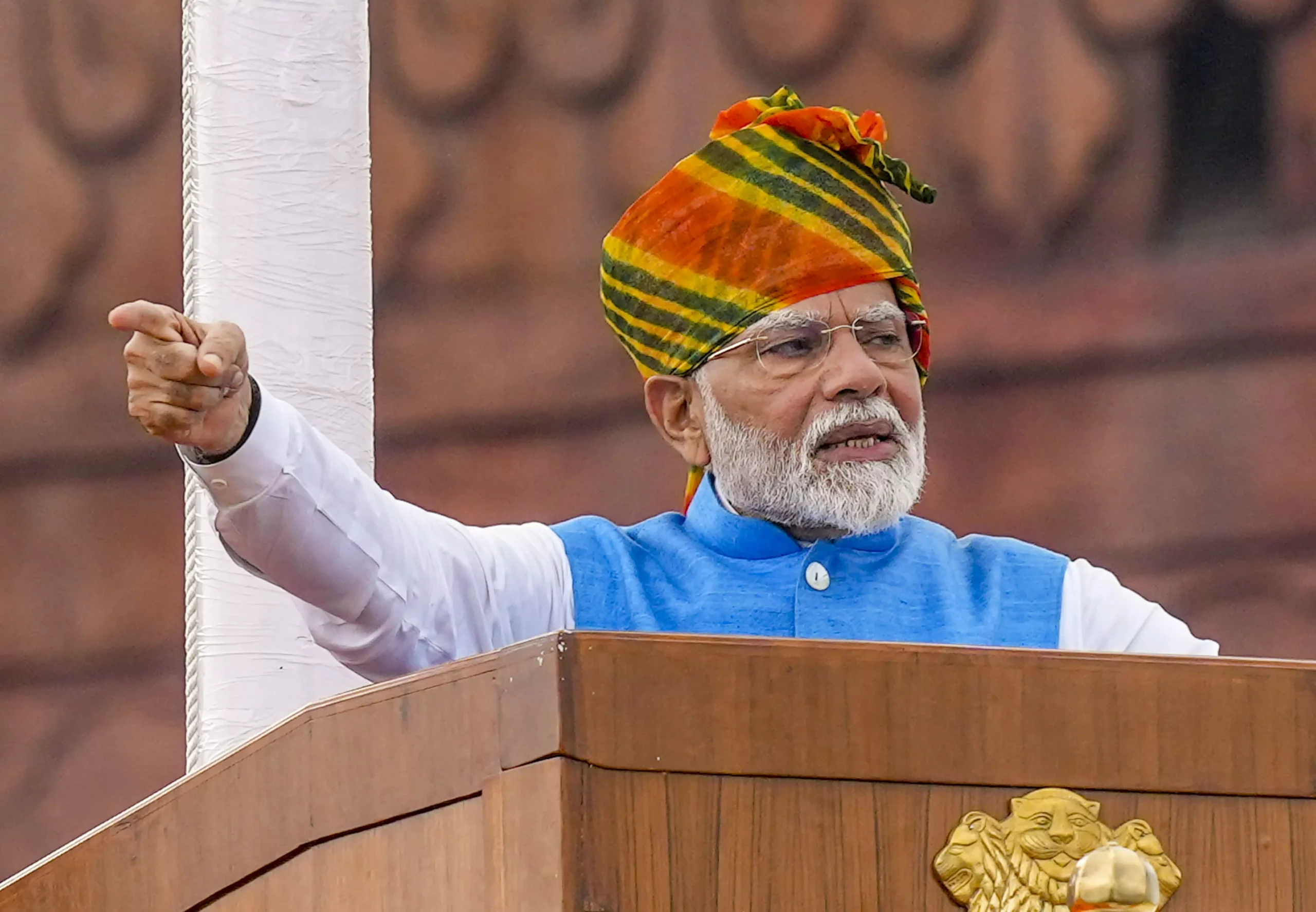
Over the last decade we have become accustomed to public spectacles mounted by the BJP with verve and grandeur. One such is the show on Independence Day. Masterful rhetoric, a mix of humility and extreme confidence and an array of “facts” rolled out by Prime Minister Narendra Modi, mesmerise the audience into a fantasy about India irrevocably rising amidst a world in disarray.
Till now the froth was backed by quinquennial evidence of growing public support for the BJP. Votes are the currency of democracy and Indians respect power acquired legitimately, more so, when it is through a leader, who rose from the ranks of the RSS to the highest political position in government, entirely on his merit and ability. He gave hope to the millions like him, that the decks stacked against them, by the elite and their progeny, can be breached by ordinary individuals with extraordinary ambition.
Sadly, however, the magic seems to have waned much like the post-Independence onset of people-oriented governments and schemes petered out within two decades into stagnation and the false dawn in Sri Lanka, India, and Bangladesh of “gender sensitive” governance by women Prime Ministers. The Modi administration’s bid to transform a State, fiercely protective of elite privileges, into one promoting social justice, has run its course within a decade, lapsing into unsustainable, low productivity state spending, creating fewer jobs than job seekers.
Notwithstanding the repeated attempts to woo tribals (about eight per cent of the population), the speech rang hollow, in the face of the tin ear for continuing displacement of Christian tribals in Imphal, Manipur. Dalits continue to resent exclusionary Hindu practices which cement hierarchical social divisions into new India. Babasaheb Ambedkar’s exhortation, that the steel frame of ritualistic Hinduism cannot be reformed to accept universal rights and dignity, still rings true. Muslims, another estranged community, and Dalits constitute a sizable one-third of the population. Farmers remain suspicious of the BJP, which puts the reform of low productivity agriculture off-limits. There is nothing new or transformational on the table for the bottom half — the marginalised India — beyond the ongoing unsustainable, poorly targeted free cereals scheme for 813 million people, the subsidised reconstruction of poor homes — 40 million till now and another 30 million more till 2029, cash transfers for 80 million farmers, low interest loans, job reservations, enhanced government employment and free or low-cost electricity.
Big government has only got bigger, particularly the internal security establishment. Good employment remains well below the annual demand for about 15 million new jobs. The economy is chugging along, fed by dollops of publicly funded outlays, fuelling inflation and public expectations of a river of freebies. None of this worries the middle class — the core support base of the BJP — who are happy that the tax on disinvesting wealth (capital gains) is lower than the tax on wages, privileging the wealthy over workers. Corporate tax reduction, import protection and performance linked incentives boost stock market valuations of businesses and might also have boosted the average wealth of Members of Parliament by 43 per cent between 2019 and 2024 (Association of Democratic Reforms). Public employment at handsome, inflation indexed, pensionable salaries, easy loans to buy appliances and homes at low real interest rates, cheap air and railway travel, cheap telecom services, low property taxes, low taxes for owning cars in overcrowded cities are add-on goodies. Road infrastructure privileges cars over buses, bicycles, or walkers.
Not surprisingly, the rhetoric from the ramparts of the historic Red Fort in Delhi sounds hollow, not least because the data cited to substantiate the “annual report card” is increasingly out of touch with reality. Consider that just minutes into his 98-minute speech, the Prime Minister said: “India has achieved more in this (renewable energy) sector than G-20 nations collectively” This is simply not true. India has ramped up RE capacity significantly by 98.4 GW over 2014 to 2022 (IRENA 2023), but it is not the only country to have done so. During the same period the 19 other G-20 countries collectively added 1,651 GW of RE capacity (16 times that of India), of which China added 801 MW (8X of India), the US added 181 MW, the EU 212 MW.
Australia and Japan together added 101 MW. Brazil and Turkey together added 106 MW and UK, France, Canada, Saudi Arabia and Mexico together added 107 MW.
Statistical gaffes or subterfuges reduce the credibility of leadership-level statements and call statistical capacity in question — a sorry state for a bureaucracy known for its punctilious attention to the minutiae, often missing the woods (forest) for the trees. This is also an outcome of the media no longer enjoying the confidence to call out unintended or
blatant mis-statements by top leaders.
Similarly, beyond the high rhetoric around becoming “Viksit Bharat” (a developed economy) by 2047, the longish speech was short on the plan to end structural impediments — public sector dominance, low efficiency of capital and low productivity, beyond assuring the “nation” that Prime Minister Modi would personally work three times as hard to make this dream come true. The ongoing national consultation on the path to 2047 seems to have thrown up public suggestions, eerily echoing the ongoing BJP programmes, indicating that a business-as-usual strategy is deemed to be sufficient.
One can hardly blame the BJP for slacking off, despite the shock reversal of widespread public approval in the 2024 general election. The Opposition remains fragmented and uninspiring — mostly family-led parties — conspiring to maximise individual gain over collective change. The BJP remains the only meritocratic party — albeit with warped metrics on what constitutes a secular way of life. It remains the hot favourite of big business and the urban middle class, whose class interests it serves well. The liberal fiscal allocations for buying support from the less privileged classes, continue unabated. In India’s first-past-the-post scheme of elections, this twin appeasement strategy, commonly adopted in Latin America and Africa, is a winner in the near-term, till the accumulated debt begins to bite and the leadership goes cap-in-hand to the IMF, for fiscal accommodation, like Pakistan has just received.
Is that why the BJP leaders on the ramparts of the Red Fort, wallowing in hubris, looked listless, and disinterested in applauding the nuggets of wisdom thrown at them unlike in previous years? Or was it a reflection of the unspoken need for introspection and reset, if the coming Haryana and Maharashtra state Assembly elections, deliver less than fulsome support.
